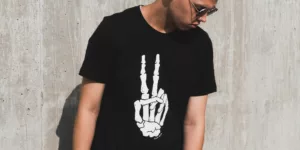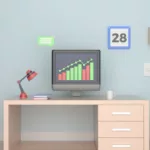A business that requires no upfront cost and very little maintenance? Yes, please!
The flexible print on demand model makes setting up an online store a painless and quick task. It’s the money making part that needs a little bit more work. But if you’ve been deliberating the idea of getting involved in the dropshipping business, let’s look at how it should be done.
What is a print on demand (POD) business?
Print on demand business is a type of dropshipping service that allows you to sell merchandise before it’s even printed. Instead of purchasing expensive equipment, printing and handling all the items yourself, you can partner with a print on demand supplier and start selling online almost effortlessly. The supplier will do all the legwork for you, including printing, packaging, shipping and even dealing with returns, while you focus on promoting your store and driving sales.
If you’re wondering what the catch is, it’s the competition. Due to such a low entry barrier, anyone can start a print on demand business. As a result, the number of new print on demand shops popping up every day is increasing. To get a slice of the ecommerce pie, you must address several critical elements before going live: you must find your niche, figure out your style and designs, find the best quality items and establish your brand.
Don’t be frightened by the to-do list, though. If people without any business experience can do it, so can you.
Why starting a print on demand business is a good idea?
If you’re looking for a side gig that is easy to maintain and has a potential to turn a sizeable profit, print on demand model might just be what you need.
1. It requires no upfront investment
That’s right, you don’t need to risk your own capital to kick off an online business. Besides the minimal costs of setting up a website and maybe getting a logo designed, your online shop can be up and running in as little as one day. You don’t need to purchase any of the stock upfront either – the POD model is designed to facilitate individual orders.
Ecommerce platforms like Shopify have a myriad of apps and integrations available to get you off to a good start. You can easily connect your online store to a chosen POD supplier and start selecting and uploading your products. When the first sale comes through, your supplier will package and ship the order on your behalf, taking care of all the behind-the-scenes tasks.
2. You don’t need to search for suppliers
One of the main reasons why print on demand is growing so fast is that it takes away the headache of finding and dealing with different partners. Instead of searching for reliable suppliers and affordable delivery options by yourself, you can use a print on demand platform like Printify to streamline the process and rather spend your time on generating sales.
What’s more, opting to use a print on demand solution might expand your horizons. Product catalogues can provide endless inspiration and ideas, so you don’t need to rely on your own imagination alone. Did you know you can brand and sell shower curtains, flip flops and even towels? One integration will open the doors of a number of respectable suppliers.
3. The profit margins are high

Print on demand can be a very profitable business. With no overheads to cover, almost everything you earn will count as profit. The markup on many print on demand items can be as high as 60-70%. The success of your online store will largely depend on your ability to identify the right niche and choose a smart pricing strategy.
How to take your print on demand business to the next level?
There are many factors at play when it comes to growing an online business, although some can be considered more important than others. Without getting these three elements right, it would be difficult to advance your business any further.
The importance of creating unique designs
If you want to compete with Zaras of the fashion world, you need to create designs that stand out and offer something that’s missing from the leading retailers. Knowing your target audience could be a huge help here. Whether you’re going after the street fashion trends or building a tongue-in-cheek brand, you must communicate that vibe through your colour choices and designs. Making the right first impression is critical. If design is not your strongest suit, work with a freelance artist to produce something truly unique. It will definitely pay off!
Figure out your pricing early on
Setting the right prices from day one is incredibly important. It will be the main factor impacting your profits, so you want to get it right. There are several different approaches to the pricing strategy for ecommerce. There’s the cost-based approach, which takes into account all the costs associated with a product and the profit margin you want to achieve; the market-oriented approach, which requires you to evaluate your competitors and set prices accordingly; and the consumer-oriented approach, which sets prices according to the perceived or estimated value of the product to the customer.
This has to be a strategic decision. Remember, cheap isn’t always the answer!
Devise a diverse marketing plan
To hit the ground running, you will need all the help you can get. Rally your friends, family and online connections to support your brand and join the community. A strong community can turn out to be a goldmine in the future, when you can start exploring other community monetization strategies besides branded merchandise.
Aim to devise a marketing plan that addresses all the main digital tactics, such as social media, Facebook and Google ads, content and email marketing. As we often learn from successful dropshipping entrepreneurs, a well-balanced marketing strategy is critical to getting the first few clients through the door. Once the word-of-mouth marketing kicks in, the lead generation becomes a smooth sailing.
Over to you
With minimal risks and a huge potential to earn money, print on demand is truly an attractive business opportunity, even for those with little business experience. If you decide to give it a go, at least you won’t ever need to ask yourself what could have happened, if you tried.








